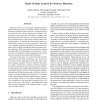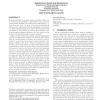848 search results - page 11 / 170 » Understanding Obfuscated Code |
PLDI
2009
ACM
14 years 9 months ago
2009
ACM
As computer systems continue to become more powerful and comdo programs. High-level abstractions introduced to deal with complexity in large programs, while simplifying human reas...
ICPR
2010
IEEE
14 years 1 months ago
2010
IEEE
Abstract--The widespread deployment of Automated Fingerprint Identification Systems (AFIS) in law enforcement and border control applications has heightened the need for ensuring t...
ACSAC
2007
IEEE
14 years 3 months ago
2007
IEEE
Malicious code is an increasingly important problem that threatens the security of computer systems. The traditional line of defense against malware is composed of malware detecto...
SASN
2006
ACM
14 years 2 months ago
2006
ACM
A great challenge in securing sensor networks is that sensor nodes can be physically compromised. Once a node is compromised, attackers can retrieve secret information (e.g. keys)...
SP
2009
IEEE
14 years 3 months ago
2009
IEEE
Malware authors have recently begun using emulation technology to obfuscate their code. They convert native malware binaries into bytecode programs written in a randomly generated...


